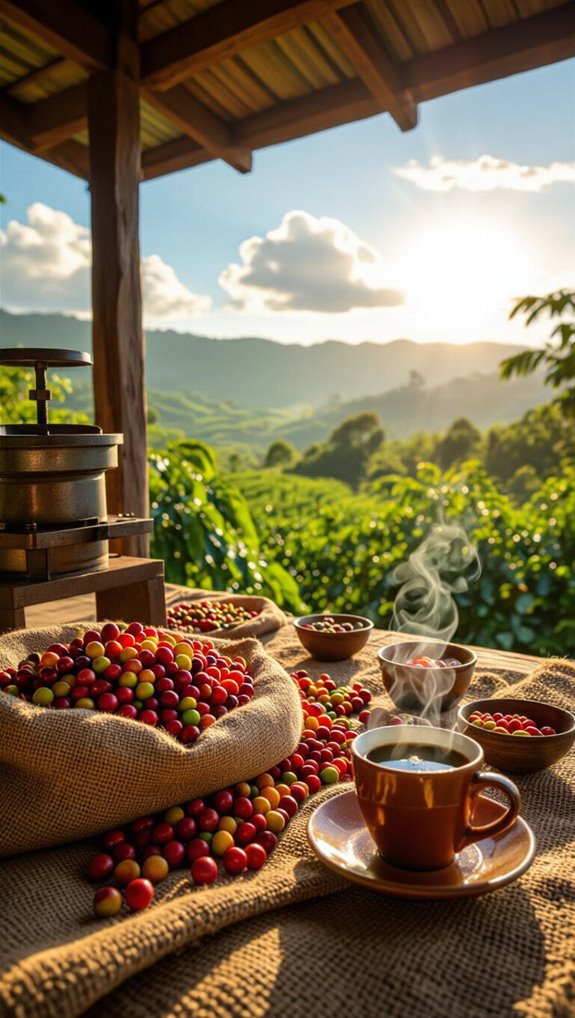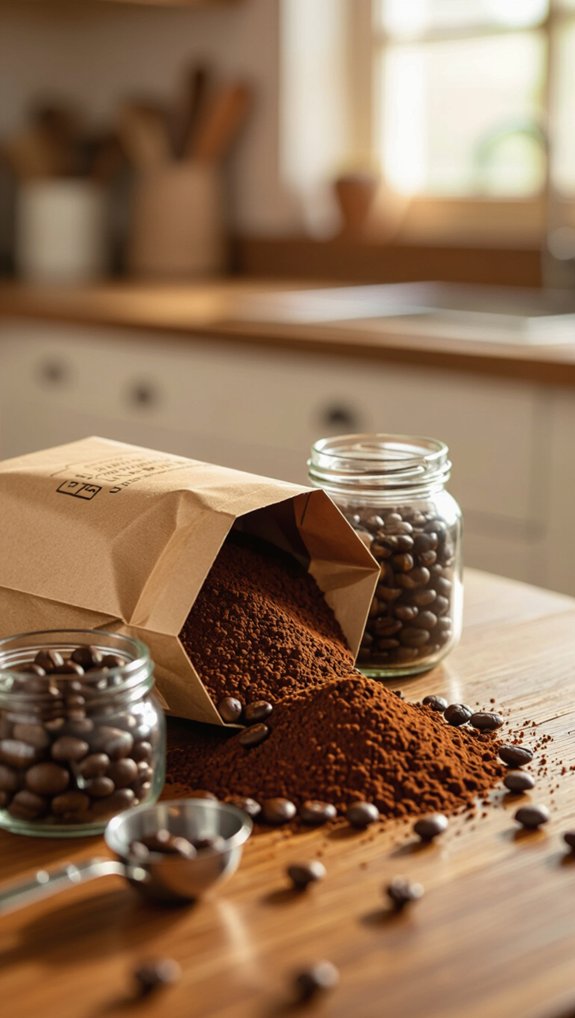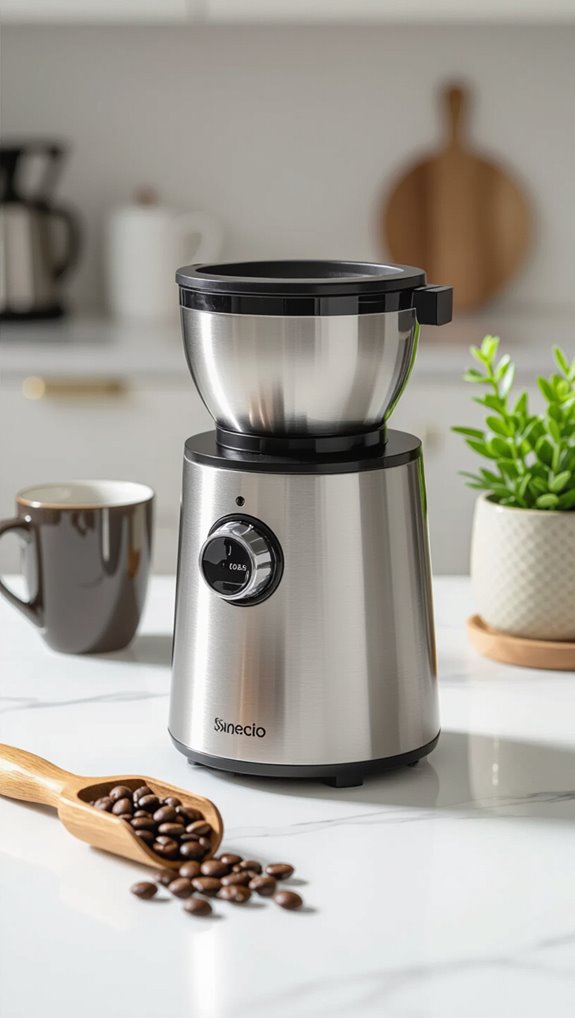Ever wondered why your coffee tastes different from cup to cup, even when using the same beans? The answer lies in coffee processing – the crucial steps that transform ripe coffee cherries into the aromatic beans in your grinder. This behind-the-scenes journey dramatically shapes every sip you take, yet most coffee lovers know little about it.
Coffee processing methods like washed, natural, and honey processing create vastly different flavor profiles, from clean and bright to deeply fruity and wine-like. Understanding these techniques will help you decode tasting notes, choose beans that match your preferences, and even improve your brewing at home.
In this guide, we’ll break down the major coffee processing methods, explain how each one affects flavor, and share practical tips for selecting and brewing processed coffees that will elevate your daily cup.
Table of Contents
What is coffee processing all about
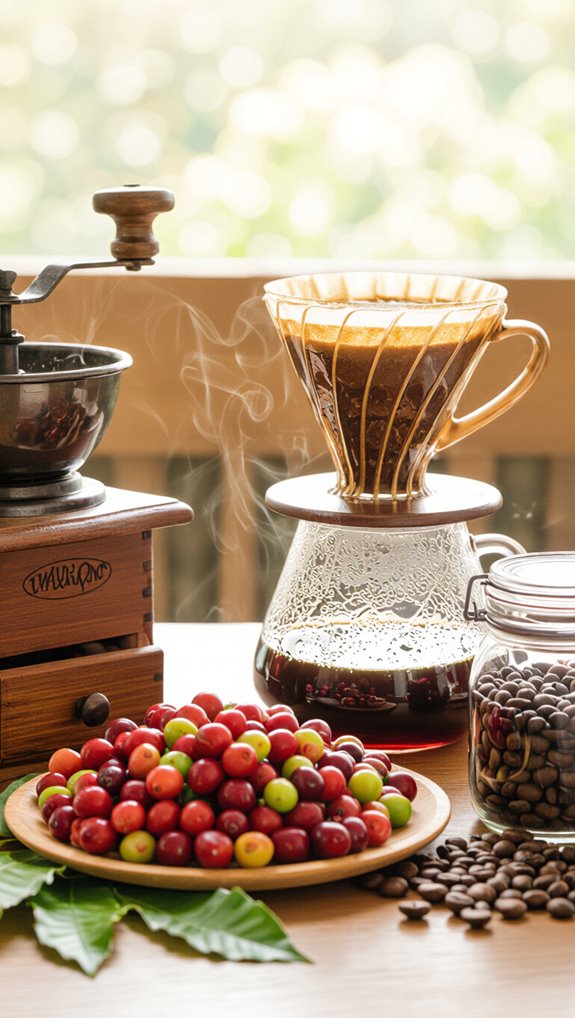
Coffee processing is the crucial journey a coffee bean takes from being a juicy, ripe cherry to becoming the green, exportable seed that’ll eventually land in your morning brew.
It’s all about transforming those cherries through strategic methods like washed, natural, and honey processing. Each technique influences fermentation, mucilage retention, and drying methods, ultimately shaping the bean’s flavor profile.
By carefully removing fruit layers and controlling moisture, producers craft coffees with distinct fruit notes—from bright and clean to syrupy and intense.
The magic happens in how long cherries are left to interact with their seeds, creating a delicious story in every cup.
How does coffee processing affect taste

Because every sip tells a story, processing dramatically transforms coffee’s final flavor profile—influencing everything from sweetness to body to acidity.
Different coffee processing methods create unique taste experiences: washed processes yield clean, bright flavors with crisp green apple notes, while natural processes develop deeper, fruitier profiles through extended mucilage contact.
Honey processing offers a beautiful spectrum between these styles, leaving varying mucilage levels that range from light and delicate to intensely sweet.
Experimental techniques like anaerobic fermentation push boundaries further, introducing wine-like fruitiness and unexpected flavor complexities that challenge traditional taste expectations.
Which coffee processing method tastes best

Ultimately, there’s no universal “best” coffee processing method—it depends on your personal taste preferences. Each processing method offers unique flavor profiles that cater to different palates:
- Washed coffees deliver crisp, clean tastes with pronounced acidity and bright fruit notes
- Natural coffees provide bold, sweet experiences with jammy, wine-like fruit flavors
- Honey processed coffees balance sweetness and body with varying fruit intensity
When exploring processing methods, consider how mucilage removal and fermentation impact body and acidity. Your ideal coffee depends on whether you prefer bright, consistent washed coffees or rich, complex natural varieties. Experiment to discover your perfect cup!
How to taste coffee processing at home

To taste coffee processing differences at home, you’ll need high-quality green coffee from the same origin processed two ways (like washed and natural), a consistent brewing method, and a systematic approach to comparing flavor profiles.
I’ll walk you through selecting your coffee, gathering equipment like a pour-over or AeroPress, and using a structured tasting technique that allows you to isolate the unique characteristics each processing method imparts.
Ingredients
Dive into the world of coffee processing by setting up a home cupping session that’ll help you unlock the subtle flavor differences between washed, natural, and honey-processed coffees. You’ll need three bags of coffee from the same origin, roast level, and varied processing methods.
Key ingredients for your tasting adventure:
- Three coffee samples (washed, natural, honey process)
- Consistent brewing equipment
- Filtered water at 200°F
- Grinder
- Cupping bowls or pour-over setup
Each processing method—washed, natural, and honey—impacts fermentation, mucilage retention, and drying, ultimately influencing the coffee’s acidity, body, and flavor notes. Prepare to explore a sensory journey!
Equipment
Because grasping coffee processing requires the right tools, I’ll walk you through setting up a simple home cupping station that’ll transform your coffee tasting experience. A precise cupping setup helps you decode flavor mysteries hidden in different processing methods.
| Equipment | Purpose |
|---|---|
| Grinder | Consistent medium-fine grind |
| Scale | Precise coffee/water measurement |
| Cupping Spoon | Professional tasting technique |
| Kettle | Controlled water temperature |
Water between 92–96°C and a precise brew ratio are critical. Your home setup mirrors professional tasting environments, allowing you to explore mucilage influence and processing nuances like a true coffee detective.
Instructions
When comparing processing methods, start by selecting two identical coffee bean batches processed differently—like washed and natural—to reveal the true flavor transformations unique to each technique.
Carefully brew both coffees using identical parameters to isolate processing impacts. Focus on sensory differences by evaluating key attributes:
- Track acidity, body, and fruit notes during cupping
- Compare dry and brewed aromas for fermentation characteristics
- Score each attribute on a 1-10 scale to objectively measure variations
The mucilage left during honey process creates fascinating intermediate flavor profiles between washed and natural methods, offering coffee lovers a delightful exploration of processing nuances.
Why do origins process coffee differently
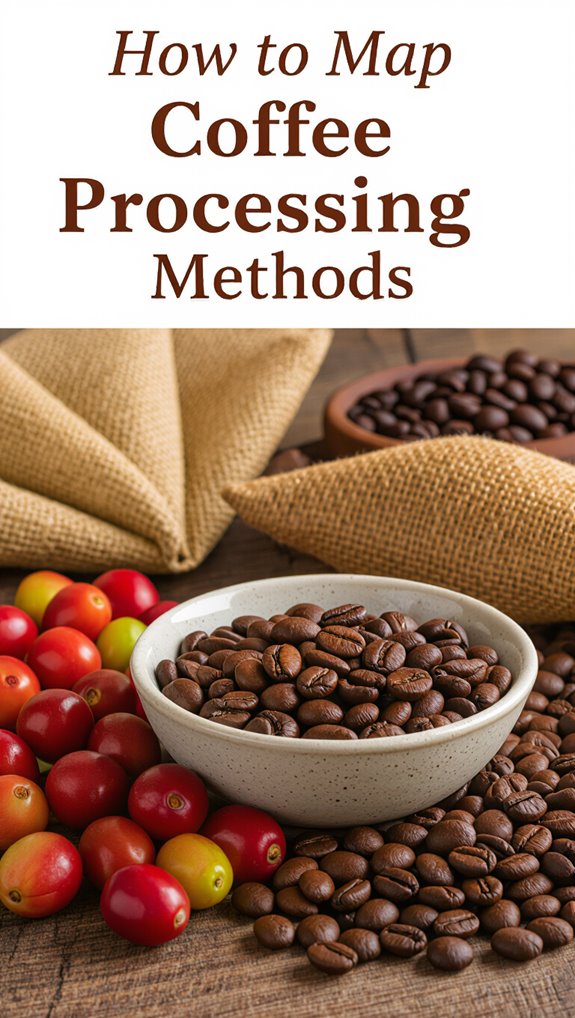
While coffee processing might seem like a uniform practice, the reality is far more nuanced, with each origin developing unique methods driven by local environmental, cultural, and economic factors.
Regional infrastructure and water availability dramatically shape processing choices: Ethiopia’s arid climate favors natural/dry methods, while Colombia’s water-rich landscape supports washed processing.
Climate, tradition, and market demands guide decisions—Indonesia’s wet-hulling technique reflects humid conditions and buyer preferences, and honey processing offers a sustainable compromise in water-limited regions.
Specialty coffee producers now experiment with innovative techniques like anaerobic fermentation to differentiate their offerings and meet evolving consumer tastes.
Washed versus natural versus honey methods
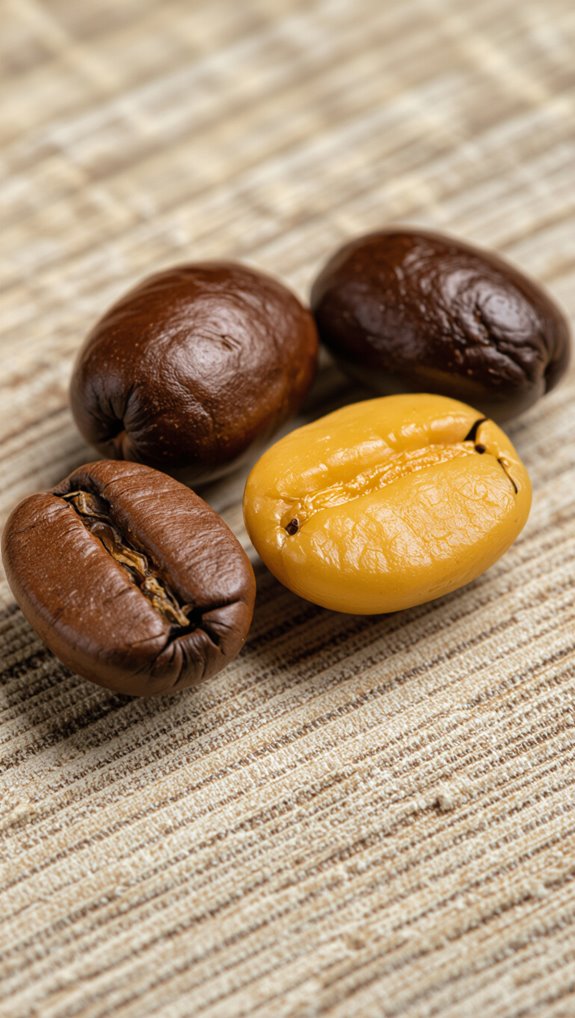
Although coffee processing methods might seem like a technical detail, they’re the secret sauce that transforms a simple coffee cherry into the complex, flavor-packed beverage you’ll love in your morning cup.
Processing dramatically shapes your coffee’s taste profile:
- Washed processing delivers clean, bright acidity with crisp flavor clarity
- Natural processing creates sweet, fruit-forward cups with pronounced body
- Honey processing balances sweetness by retaining varying levels of mucilage
Each method involves strategic drying and fermentation techniques.
Washed beans are depulped and fermented 12–72 hours, while natural methods dry whole cherries on beds for weeks.
The honey process sits between these extremes, leaving partial mucilage for nuanced flavor development.
Fermentation, drying, and milling steps explained
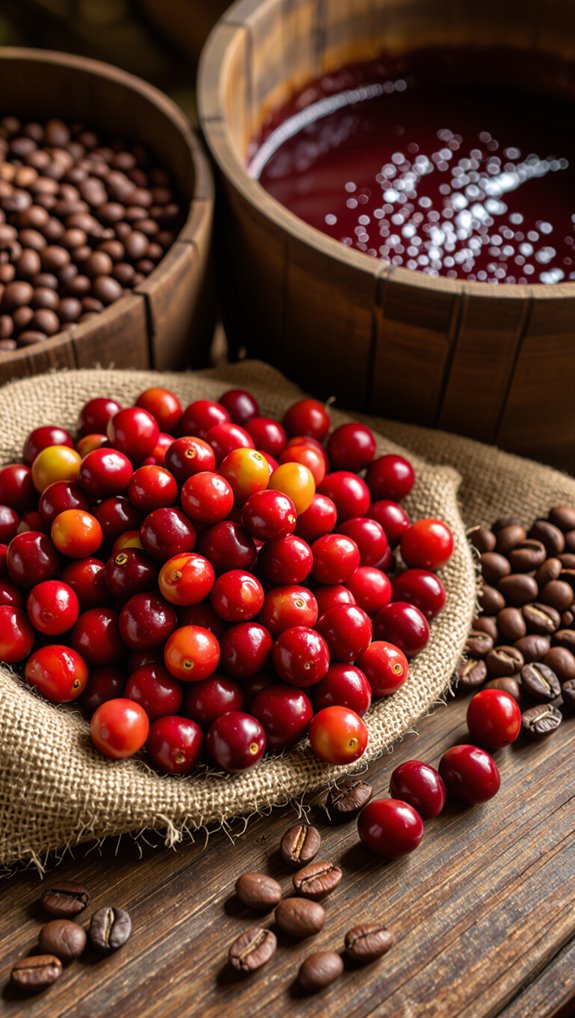
Let’s break down the coffee processing journey through fermentation, drying, and milling—the crucial transformation steps that turn coffee cherries into those aromatic green beans ready for roasting. Each stage dramatically influences flavor, with fermentation in tanks allowing microbes to break down mucilage and develop unique taste profiles. Temperature and timing are critical—too long risks off-flavors, while controlled fermentation enhances clarity.
| Stage | Duration | Key Process |
|---|---|---|
| Fermentation | 12-72 hrs | Mucilage breakdown |
| Drying | 1-4 weeks | Moisture reduction |
| Milling | Hours | Parchment removal |
Drying on raised beds reduces moisture from 60% to 10-12%, concentrating flavors and preventing mold through careful turning.
Processing impact on body and aroma
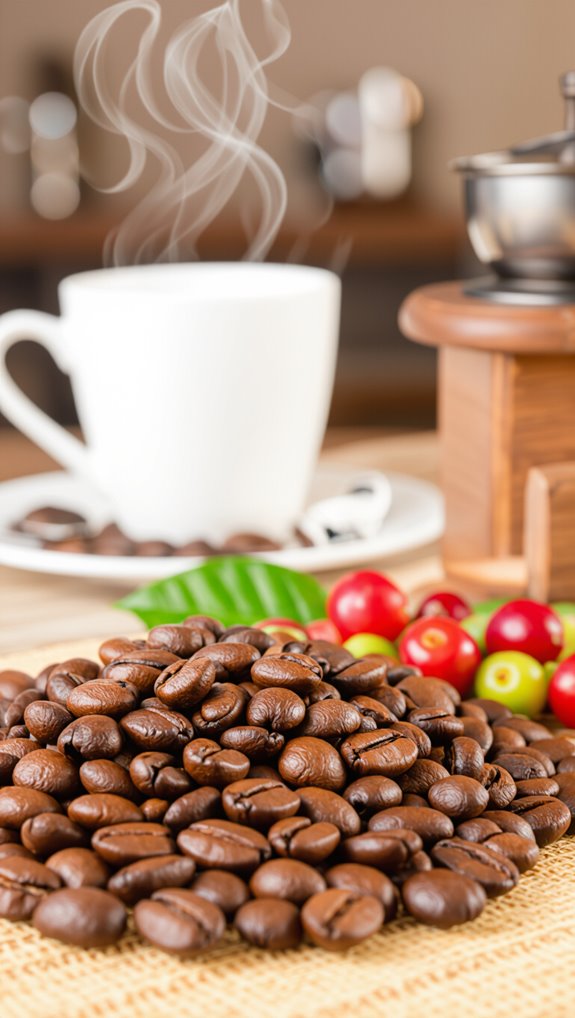
Coffee processing doesn’t just sort beans—it sculpts flavor, body, and aroma through intricate microbial and chemical transformations.
Different methods dramatically influence your cup’s character, from the syrupy richness of natural processing to the bright clarity of washed processing.
Key flavor transformations include:
- Mucilage retention during Honey process creates progressively sweeter, fruitier profiles
- Anaerobic fermentation amplifies complex wine-like and tropical aromatics
- Extended drying periods develop deeper, more intense fruit flavors
Each technique manipulates body and aroma by controlling microbial interactions, sugars, and volatile compounds during fermentation and drying stages.
Buying tips by processing and roast

Navigate your coffee buying journey by matching processing methods and roast levels to your flavor preferences.
Washed process coffees from Colombia or Guatemala deliver clean, bright flavors—opt for light to medium roasts to highlight crisp fruit notes.
Natural process beans from Ethiopia showcase intense sweetness with fuller body; choose medium roasts for winey, jammy characteristics.
Honey processed coffees from Costa Rica balance sweetness and clarity through medium roasts.
For espresso lovers, seek consistently processed beans with slightly darker roasts to ensure stable, predictable flavor shots across batches.
Brewing tweaks for each processing method
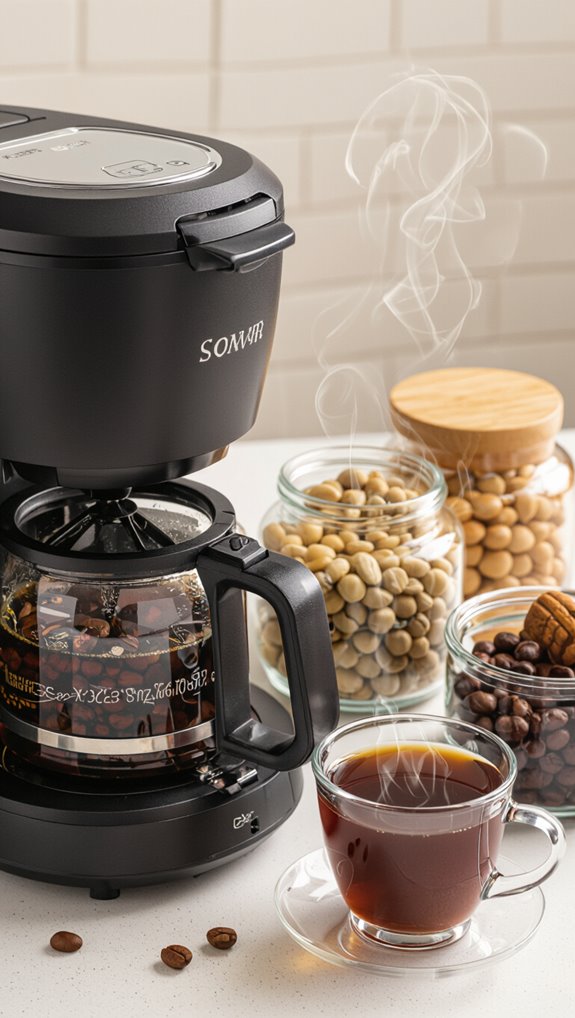
Because brewing methods can dramatically transform your coffee’s flavor profile, mastering technique for each processing method is crucial for unlocking the most delicious cup. Comprehending how processing impacts extraction helps you dial in the perfect brew.
- Natural-processed coffees shine with coarser grinds and shorter brew times to highlight fruity sweetness
- Washed coffees benefit from finer grinds and longer contact to enhance bright acidity
- Honey-processed coffees love medium grind settings and slightly warmer water temperatures
Each processing method demands unique brewing approaches to maximize flavor potential, turning your home brewing into an artful experience.
Frequently Asked Questions
How Long Can Processed Coffee Beans Stay Fresh Before Roasting?
I recommend storing green coffee beans in a cool, dry place for up to 12 months. Beyond that, their flavor and quality start to deteriorate, so I suggest using them within a year of processing.
Are There Health Differences Between Various Coffee Processing Methods?
I’ve found that different processing methods can impact coffee’s antioxidant levels and potential health benefits. Natural, washed, and honey processing each affect nutrient retention and potential health-promoting compounds slightly differently.
Can Home Roasters Experiment With Different Coffee Processing Techniques?
Yes, I can help you explore home coffee processing! You’ll need green beans, basic roasting equipment, and patience. I recommend starting with air roasting or small drum roasters to experiment with different techniques and develop unique flavor profiles.
What Equipment Is Needed to Process Coffee at Home?
I’ll need a few key tools: a moisture meter, drying screens, large buckets, a de-pulping machine, and space for fermentation. You’ll want clean, food-safe equipment and a controlled environment to successfully process your green coffee beans at home.
Does Coffee Processing Affect Caffeine Content in the Final Brew?
Yes, coffee processing does impact caffeine content. I’ll tell you that the method affects caffeine levels, with light roasts typically retaining more caffeine than darker roasts, and certain processing techniques can slightly alter the final caffeine concentration.
In Conclusion
Understanding coffee processing methods is the key to unlocking extraordinary flavors in your daily cup. Whether you’re drawn to the bright acidity of washed coffees, the fruit-forward intensity of natural processing, or the balanced sweetness of honey-processed beans, each method offers a distinct pathway to coffee excellence. The journey from cherry to cup reveals how processing techniques directly influence the complex flavor profiles that make each origin unique.
As you explore these different processing methods, having the right equipment becomes essential for extracting the best from your carefully chosen beans. The most sophisticated processing techniques won’t reach their full potential without proper brewing equipment that can highlight these nuanced characteristics.
For coffee enthusiasts ready to elevate their home brewing game, our comprehensive coffee machine reviews showcase smart, well-reviewed options that will help you extract the full potential from processed beans. From precision temperature control to optimal extraction timing, the right machine transforms your understanding of coffee processing into consistently exceptional cups that celebrate each method’s unique contribution to flavor.

